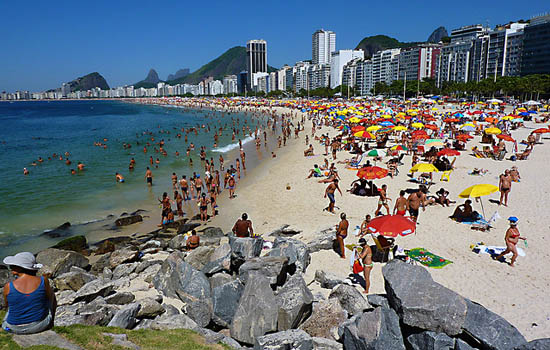Copacabana Beach, Rio de Janeiro: A Timeless Icon of Beauty, Culture, and Leisure

Introduction: Nestled along the vibrant coastline of Rio de Janeiro, Copacabana Beach stands as a symbol of Brazil’s rich culture, natural beauty, and joie de vivre. With its iconic crescent-shaped shoreline, golden sands, and bustling promenades, Copacabana Beach has captured the hearts and imaginations of travelers from around the world for generations. In this comprehensive article, we will embark on a journey to explore the allure and charm of Copacabana Beach, delving into its history, attractions, cultural significance, and the unique experiences it offers to visitors seeking sun, sand, and adventure.
A Brief History: Named after the Virgen de Copacabana, the patron saint of Bolivia, Copacabana Beach was originally a quiet fishing village that gradually transformed into one of the world’s most famous beach destinations. The beach gained international prominence in the early 20th century with the construction of luxurious hotels, elegant promenades, and vibrant nightlife venues that attracted tourists and celebrities from around the globe. Over the years, Copacabana Beach has evolved into an iconic symbol of Rio de Janeiro’s vibrant culture and laid-back lifestyle, drawing millions of visitors each year to its shores.
Geography and Landscape: Stretching for approximately 4 kilometers (2.5 miles) along the Atlantic coast, Copacabana Beach is renowned for its pristine sands, azure waters, and breathtaking vistas. The beach is flanked by the towering peaks of Sugarloaf Mountain to the south and the iconic Copacabana Fort to the north, creating a picturesque backdrop for sunbathers, swimmers, and beachgoers. The bustling Avenida Atlântica runs parallel to the beach, lined with palm trees, kiosks, restaurants, and hotels that offer a vibrant and eclectic atmosphere day and night.
Attractions and Activities: Copacabana Beach offers a wealth of attractions and activities to suit every interest and inclination. Sun worshippers can bask in the warm Brazilian sunshine on the beach’s golden sands, while water sports enthusiasts can try their hand at surfing, stand-up paddleboarding, or beach volleyball. The beach’s iconic boardwalk, known as the “calçadão,” is perfect for leisurely strolls or bike rides, offering stunning views of the coastline and lively street performers. Visitors can also explore the historic Copacabana Fort, which houses a military museum and offers panoramic views of the beach and surrounding cityscape.
Cultural Significance: Beyond its natural beauty and recreational opportunities, Copacabana Beach holds deep cultural significance as a symbol of Brazilian identity, pride, and joie de vivre. The beach has been immortalized in countless works of literature, music, and film, capturing the essence of Rio de Janeiro’s vibrant spirit and multicultural heritage. From the sultry rhythms of bossa nova to the colorful celebrations of Carnival, Copacabana Beach serves as a backdrop for some of Brazil’s most iconic cultural traditions and celebrations, drawing visitors and revelers from around the world to experience its infectious energy and festive atmosphere.
Nightlife and Entertainment: As the sun sets over the horizon, Copacabana Beach comes alive with an electrifying nightlife scene that pulses with energy and excitement. The beachfront bars, clubs, and restaurants along Avenida Atlântica offer a diverse array of dining and entertainment options, ranging from casual beachside cafes to upscale rooftop lounges. Visitors can sip caipirinhas and dance the night away to the sounds of samba and bossa nova, immersing themselves in the vibrant rhythms and infectious energy of Rio de Janeiro’s legendary nightlife.
Preservation and Conservation Efforts: Despite its popularity and fame, Copacabana Beach faces threats from pollution, overdevelopment, and the effects of climate change. Local authorities and environmental organizations are actively engaged in preservation and conservation efforts to protect the beach’s natural beauty and ecological integrity for future generations to enjoy. Initiatives such as beach clean-up campaigns, recycling programs, and sustainable tourism practices aim to minimize the impact of human activities on the beach and promote responsible stewardship of this iconic natural treasure.
Conclusion: Copacabana Beach, Rio de Janeiro’s timeless icon of beauty, culture, and leisure, is a place of endless possibilities and unforgettable experiences. Whether basking in the sun on its golden sands, strolling along its bustling boardwalk, or immersing oneself in its vibrant nightlife and cultural scene, Copacabana Beach offers something for everyone to enjoy. As a symbol of Brazil’s rich heritage and joie de vivre, Copacabana Beach continues to inspire and enchant visitors from around the world, beckoning them to experience its magic and embrace the spirit of Rio de Janeiro’s vibrant coastline.




